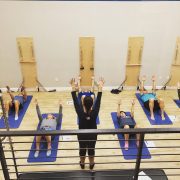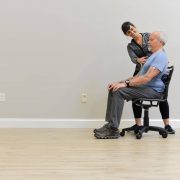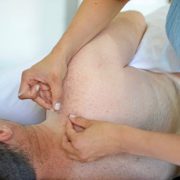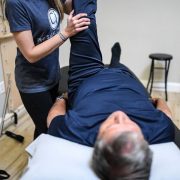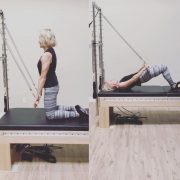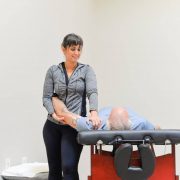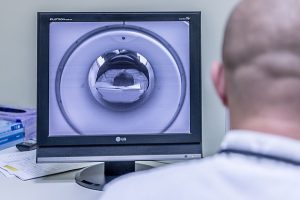Knee pain is one of the most common complaints that brings people into our office.
Since most of our clients are in their 40’s, 50’s and 60’s, they start to really worry that knee pain could bring an end to their active lifestyle. But that doesn’t have to be the case! The good news is that unless you’ve had some serious trauma (like a major accident or fall), 80% of all knee problems can be resolved without any kind of procedure or surgery – and most importantly – you can learn how to continue managing them on your own so that they never get in the way of your favorite activities again.
Sound too good to be true?
It’s not – I promise – but the first step is figuring out where your knee pain is coming from. Once you know that, you can get on the right path to resolve it.
Here are three of the most common causes I see that make people suffer from knee pain and what you can do about them:
1. Iliotibial band syndrome
This is a very common problem that typically affects runners, avid walkers, and hikers. It is often misdiagnosed and confused with patellofemoral syndrome (see below). Your iliotibial band (IT band) is a very large thick band on the side of your knee that will often get overworked due to a muscular imbalance elsewhere in your body (usually your hips and core). When this happens, you’ll feel pain that is on the side of your knee that is usually very sore and tender to touch, and typically sharp and stabbing versus achy. It will impact you most when you’re going downhill or down the stairs.
It’s important to note that even though a tight, and painful IT band is the structure causing you to have pain – it is typically a symptom of an underlying problem. Like I said before, IT band problems are usually the result of your core and hips not stabilizing your pelvis properly – which ultimately results in your knee not receiving the support it needs when you’re running, walking, or hiking.
Getting rid of the actual pain is the easy part… in our office we use things like dry needling, soft tissue work, and sometimes even some taping. But if you want to keep the pain gone – you MUST address the underlying causes as well. This is what a lot of people miss. We love using Pilates-based exercises in our office because they not only target your core, but also get your muscles working in a coordinated, symmetrical fashion, helping to keep things balanced as you get back to your favorite activities.
2. Patellofemoral Knee syndrome
This problem is very similar to IT band syndrome, with just a few key differences. This first is that it can impact almost anyone – not just runners, hikers, and walkers. You’ll also experience the pain in the front of your knee – typically under your kneecap – and it will tend to be more achy than sharp. This problem will often come on very slowly and can be more chronic than its IT band cousin. You’ll feel this more when you’re going up stairs, up hills, and with squatting. You’ll also notice stiffness and pain in the front of your knee after sitting awhile – that usually will go away once you start moving.
Much like IT band syndrome – these are all symptoms of an underlying cause. A weak core and hips can cause this problem too, but I usually see more weaknesses in glutes and hamstrings with this one. When the backs of your hips and legs aren’t kicking in like they should, it can result in tight hip flexors or quads. This is a super common culprit for patellofemoral syndrome. So once again, you can get rid of the pain quite easily in most cases, but you must make sure to determine – and address – the root cause so that you can keep this pain gone for good.
3. Osteoarthritis
Many people hear that they have osteoarthritis in their knee and think there isn’t anything they can do about it. Not true!! Arthritis is often blamed for knee problems but it isn’t always the cause of what you’re feeling… Let me explain….
When arthritis is the true cause and culprit for your knee problem, it will be painful and stiff all the time. You’ll lack significant mobility and it will be almost impossible to walk and bear weight without support or a cane. When this is truly your problem – you are a great candidate for total knee replacement surgery. Now here’s the catch… sometimes your X-ray or MRI will show that you have terrible arthritis or that you have “bone-on-bone”… but that doesn’t mean you need to rush to surgery! Your symptoms should really decide that.
If your pain comes and goes (meaning you have good days and bad days), if you can walk around most days and go up and down the stairs and your knee just “catches”, or maybe you feel stiff a lot but this eases up with movement – you might have arthritis in your knee but it is not the root cause of your knee problem. Because here’s a hint – arthritis does NOT come and go – but other common musculoskeletal problems can. When your pain comes and goes, you know it can’t be entirely from arthritis.
So what should you do?
With arthritis, whether it’s partially to blame, or whether it’s just something that shows up on the X-ray and gets blamed… we still need to look at the surrounding structures and root cause of the problem.
If your quads are really tight, and the muscles around your knee are imbalanced, this can create compressive forces in your knee joint which will exacerbate what might normally just be “mild” arthritis (compression will aggravate arthritis). You could also have weakness or problems in your ankles, feet, or core that are causing your knee to work harder than it needs to. This can cause pain all on its own, OR aggravate your arthritis. The point is, get checked by a musculoskeletal expert – people trained like us – so that instead of just fishing for the problem or only treating symptoms, you are getting to the root cause of your problem and setting yourself up for success!
If any of this sounds familiar to you, you may benefit from working with a specialist physical therapist who can help you get back to the activities you love – without pain pills or unnecessary procedures. You can click right here to request a FREE Discovery session with one of our specialists. We’d love to help you figure out the root cause of your knee problem so that you can get back to doing everything you love – instead of spending time in the doctor’s office 🙂

